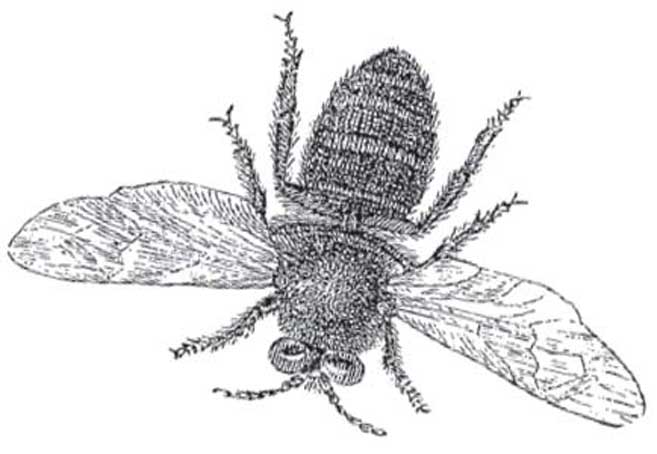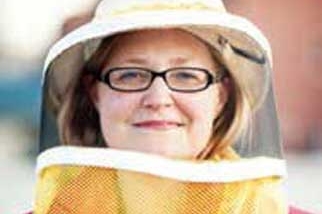The Buzz on Bees
It’s all about relationships — with a bonus of honey
Carrie Van Winkle is a beekeeper. If your mind’s eye immediately called up a picture of a farm woman standing amid dozens of hives next to acres and acres of blossoming crops, think again. Carrie Van Winkle’s bees live in only five hives. One is in her small Deer Park neighborhood backyard. Two are on an empty lot owned by a friend near Cave Hill Cemetery. The last two are on the roof of Harvest Restaurant on East Market Street in the citified heart of NuLu. Carrie is part of a new breed: the urban beekeeper. She’s also a “natural” beekeeper, as opposed to a commercial one, so while honey is nice, it’s not really the point.
When asked how many quarts of honey her bees produce annually, Carrie laughs and then says, “A natural beekeeper doesn’t really like that question.”
Like many contemporary beekeepers, Carrie’s focus is “truthfully, to support a healthy honeybee population.” According to the Back Yard Beekeepers Association, honeybees account for 80% of all insect pollination.
Carrie notes that honeybees are prime pollinators not just in the countryside, but in the cityscape as well.
“Why do we need urban honeybees? The local food system is very important to me. How do we continue to create sustainable local food? People talk about everything else but forget pollination. If we want to grow food in our backyards, we need pollinators. If you want a garden, you need honeybees.” But there’s more to it than just good gardening, Carrie says. “Urban beekeeping is really about relationships.”
For starters, there’s the relationship between hives. Most beekeeping manuals insist that even the smallest operation should have at least two hives. Rural beekeepers usually have 10 to 100, Carrie notes.
“Old-time beekeepers were not as dependent on anyone else.” Carrie began with one hive because that was what suited the small space she had. Most urban beekeepers keep from two to five hives, she said, and she soon discovered why.
“A hive goes through cycles and faces challenges that can be solved by pulling from one hive to another. If you have one hive alone, you don’t have that resource.” You can build a relationship with another nearby beekeeper to use his or her hives as a resource, Carrie said, or you can expand your own operation. Which can lead to more relationships.
Her Cave Hill hives are on a lot owned by a friend she made when teaching a class on urban beekeeping at Fox Hollow. He didn’t decide to become a beekeeper, but told her about “a beautiful little lot, and how he was looking for a good use for it.” Soon her two new hives were there and the lot was christened Ruby’s Apiary after the owner’s daughter.
Then in 2011 she contacted Ivor Chodkowski at Harvest restaurant to see if he’d be interested in having hives there as part of their local food focus. The answer was yes. The two hives on the roof of the restaurant do produce some honey that does occasionally appear on the menu, but again, Carrie says, that’s not the point.
“We don’t expect to have a lot of honey, but it’s a way for people to learn about bees. It’s a conversation starter.” And conversation, she notes, is a part of relationships.
Which leads the conversation to the most frequent question an urban beekeeper hears:
“What will the neighbors think?” Carrie laughs. That, too, is a matter of relationship.
“In the city, a beekeeper’s best friend is her neighbor.” But how do you build a good relationship with folks who may not know much about honeybees, or may think they know “facts” that are in fact myths?
“When I decided to keep honeybees, I read every book I could get my hands on about urban beekeeping, and on the neighbor question they split emphatically one way or the other. Either they said it was best to talk with your neighbors first, to get them on your side before you brought the bees in. Or they said the best way was to start without saying anything and after you’d had bees with no incident for a year, take some honey to the neighbors and tell them what you’ve been doing.”
Carrie decided she’d go with Door Number Two. A garage blocked the view of the neighbors on one side, and she decided to build a privacy fence along the boundary with the neighbor on the hive side. But when she told that neighbor about the fence, it caused some consternation.
“My neighbor just didn’t want that fence. I told her I didn’t expect her to pay for it, but she was still upset. So I finally told her why I wanted it, that I intended to keep bees. And she said, ‘Oh, honey, I don’t care about bees! I just don’t want you to put up that big old fence.’”
Carrie ditched the fence idea, and now when she harvests any honey “I take some to that neighbor first.
“I’m so lucky that my neighbors understand,” she adds. “They get it: You can’t have your awesome garden in your backyard if you don’t have a beekeeper in your neighborhood.” Ronni Lundy is a Kentucky native living and writing in North Carolina. Find her at www.RonniLundy.com.

BEE HERE NOW
If you’re thinking about taking up urban beekeeping, right now is a good time to begin learning how. The Kentucky State Beekeepers Association’s Bluegrass Beekeeping School is in Frankfort, March 9. Information on this class and other KSBA programs can be found at KSBABeekeeping.org.
Carrie Van Winkle will be teaching Beekeeping 102 at Foxhollow Folk School on April 13. For more information or to register, see www.Foxhollow.com/event-calendar/beekeeping-102-with-carrie-vanwinkle-of-fleurdebee-beekeeping
Carrie also does individual consultation and can be contacted through www.Fleur-de-Bee.com.
Honey — A Sweet Partner In The Kitchen
As urban beekeeping is all about relationship, so is cooking with honey. Honey plays well with others in the kitchen, pairing nicely with other sweeteners, with savory spices and herbs and with the occasional potable. In Fried Chicken: An American Story, Southern food scribe John T. Edge notes that a number of purveyors, from Hays, Kansas, to Paris, France, serve the classic bird hot with honey on top. Greenwood’s on Green Street in Roswell, Georgia, dunks fried chicken in honey and then tops that with pepper vinegar, while Julep in Jackson, Mississippi, infuses honey for fried chicken with rosemary.
Here are some recipes that illustrate honey’s further diversity.
RECIPES
BEE-ING AN AMBASSADOR
Carrie Van Winkle says part of the function of an urban beekeeper is to be an ambassador for bees, to not only educate about the honeybee’s value but to dispel common myths about danger. The greatest? That honeybees are aggressive.
“A bee can only sting once, and when it does, it dies. Once you get that fact in your head, you realize that a bee is not programmed to just go out and sting. They will only sting when they feel they are being attacked. If you’re running through the yard barefoot and you get stung because you stepped on a bee, that’s not an act of bee aggression.” Neither is swarming.
“Swarming happens when one hive gets large enough to give birth to a new hive. When that happens a group of bees break off from the original hive and go off to find a new place to have a hive. These bees have no motivation to be aggressive when they are doing that.
“Sometimes the swarm will land on a car bumper or a tree to rest. It’s hard work to find a new hive, and so they need to rest. It can look scary, I know, but once people understand what they are actually seeing—that this is not a pack of aggressive creatures, but this amazing life experience—then a swarm becomes a remarkable thing to see, not a threat.”
Part of the urban beekeeper’s work, she says, is to control swarming by breaking apart hives when they begin to grow, and providing a new hive for the extra bees. Carrie is also sometimes contacted to come “rescue” a swarm that has landed. In addition to traditional beekeeper’s protective gear, her equipment in that circumstance includes a box with a lid and air holes.
“If you can just get the queen in the box, everybody else will just pile in,” she says. “If they’re on a branch, you can just knock ’em in.” A recent swarm rescued near Southwestern Parkway at Chickasaw Park became a hive for the Portland Orchard Project.
Sesame Dream Bars
Adapted from Frances Moore Lappe’s Diet for a Small Planet, these dreamy dessert bars are something I’ve been making for over 40 years now, loving how the honey and brown sugar work in harmony with the nutty sesame seeds. (Lappe uses margarine instead of butter and ¼ cup of soy flour to replace the equivalent amount of whole-wheat flour to up the protein. She also says to grind the sesame seeds lightly, but I find it works as well and is less bother to just use them whole. I also often make this with no coconut and extra sesame seeds.)
Ingredients
COOKIE BASE
- ½ cup butter, softened
- ½ cup honey (dark is yummy)
- 1½ cups whole-wheat flour
TOPPING
- 2 eggs
- 1 teaspoon vanilla
- ¾ cup brown sugar
- ¼ cup wheat flour
- ½ teaspoon baking powder
- ½ cup unsweetened shredded coconut
- ½ cup sesame seeds (may grind slightly, if you wish)
Instructions
Butter or oil a 9- by 13-inch pan. Preheat oven to 350°.
Cream together butter and honey until light and fluffy. Gradually add flour and blend well. Spread evenly in pan and bake for 20 minutes, until firm and just turning color. Remove from oven, leaving oven on, and allow cookie base to cool while you prepare the topping.
Beat eggs until light, then add sugar and honey and mix well. Mix flour and baking powder together and add to egg mixture along with coconut and sesame seeds. Use a spatula to spread evenly over the top of the cookie base. Return to 350° oven and bake for 20 additional minutes. Let cool before cutting into squares. Makes 18 to 20 bars.
Krupnik
Sandra Mlinarcik grew up on the South Side of Chicago and took her Polish Easter traditions with her when she moved to Louisville several years ago. In 1995 she shared many of them, along with recipes, in her book The Festive Table. One of the most intriguing was this for a honeyed, spicy vodka liqueur.
Ingredients
- 1½ cups honey
- 1 teaspoon vanilla extract
- ¼ teaspoon ground nutmeg
- 2 cinnamon sticks
- 2 whole cloves
- 3 strips lemon peel, each about 2 inches long
- 750 milliliters very good vodka
Instructions
- In a large saucepan, combine the honey with ⅔ cup water, the vanilla, spices and lemon peel. Bring to a boil over high heat. Cover, turn the heat down to medium and simmer for 5 minutes. Remove from heat and immediately add the vodka. Stir and then pour into a large ceramic or glass pitcher. Cool, then cover. Let stand for at least 24 hours, up to 3–4 days. Strain to remove the spices. May be warmed very gently or chilled for serving.
- Makes enough for a dozen folks to sip.








